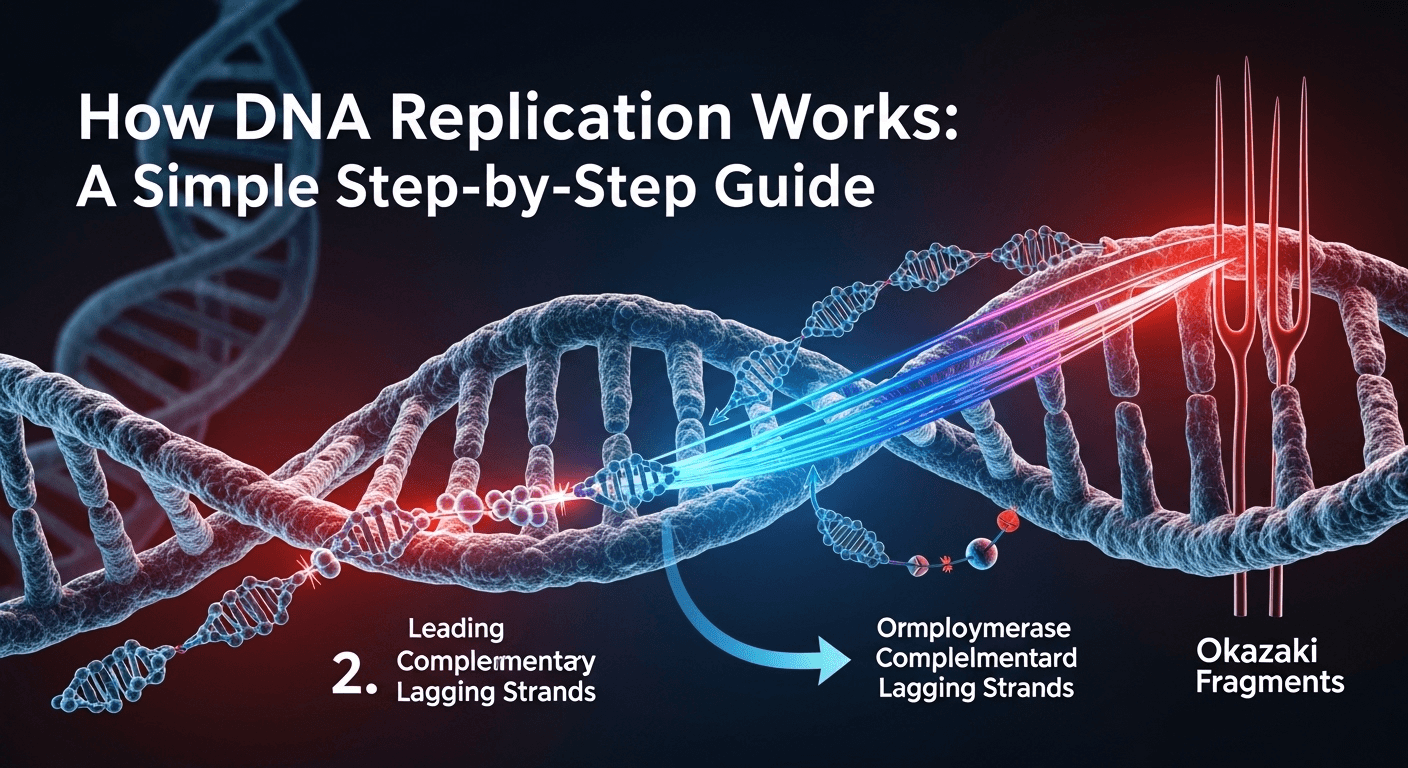Every living organism, from the smallest bacterium to the largest blue whale, carries a microscopic instruction manual in nearly every one of its cells. This manual, known as DNA, dictates everything from eye color to how our bodies fight off disease. But for life to continue, for cells to divide, for organisms to grow and repair themselves, this intricate manual must be copied with incredible precision. This fundamental process is called DNA replication. If you've ever wondered how does dna replication work, you've come to the right place. This guide will break down this complex biological marvel into simple, understandable steps, revealing the elegant molecular machinery that makes life possible.
Table of Contents
ToggleWhat is DNA and Why Does It Need to Replicate?
At its core, Deoxyribonucleic Acid (DNA) is a molecule that contains the genetic code for an organism. It's often visualized as a twisted ladder, a structure called a double helix. The "rungs" of this ladder are made of pairs of four chemical bases: Adenine (A), Guanine (G), Cytosine (C), and Thymine (T). A crucial rule governs these pairings: Adenine always pairs with Thymine (A-T), and Cytosine always pairs with Guanine (C-G). This specific pairing is the key to DNA's ability to be copied accurately. The sequence of these bases along the ladder's "sides" forms the genes that provide instructions for building and maintaining an organism.
The need for replication is intrinsically tied to the life cycle of cells and organisms. Consider this: you started as a single cell, which then divided into two, then four, and so on, until you became the complex organism you are today, made of trillions of cells. Every time a cell divides (a process called mitosis), both new daughter cells need a complete and identical copy of the original DNA instruction manual. Without DNA replication, cell division would be impossible. This process is also vital for growth, repairing damaged tissues (like when you heal from a cut), and for creating sex cells (gametes) for reproduction.
The genius of DNA replication lies in its semi-conservative nature. This term, which sounds complex, describes a beautifully simple concept. When a DNA molecule replicates, it doesn't create a brand-new copy from scratch. Instead, the double helix "unzips" down the middle, and each of the two original strands serves as a template for building a new, complementary strand. The result is two new DNA molecules, each consisting of one old (parental) strand and one newly synthesized strand. This method ensures an extremely high degree of fidelity, minimizing errors and preserving the genetic code across generations of cells.
The Key Players: Enzymes and Proteins in DNA Replication
DNA replication isn't a magical event; it's a highly coordinated process orchestrated by a team of specialized proteins and enzymes. These molecules are the microscopic workers on the cellular assembly line, each with a specific and vital job. An enzyme is a biological catalyst—it speeds up chemical reactions without being consumed in the process. In the context of DNA replication, these enzymes perform tasks like unzipping, building, and proofreading with astonishing speed and accuracy.
Understanding the main players is essential to understanding the entire process. While many proteins are involved, a few key enzymes perform the most critical functions. They work together in a complex called the replisome, a "replication machine" that moves along the DNA. Think of them as a highly efficient construction crew, each member knowing their precise role and timing.
Here are the star members of the DNA replication team:
- Helicase: The "Unzipper." This enzyme's primary job is to break the hydrogen bonds holding the two DNA strands together, unwinding the double helix and creating a Y-shaped structure known as the replication fork.
- Primase: The "Primer." DNA's main builder enzyme can't start a new chain from scratch. Primase solves this by creating a short RNA (Ribonucleic Acid) sequence called a primer. This primer acts as a starting block for the DNA synthesis to begin.
- DNA Polymerase: The "Master Builder." This is the main enzyme responsible for synthesizing new DNA. It "reads" the template strand and adds complementary nucleotides (A, T, C, or G) to create the new strand. It also has a crucial proofreading function, like a backspace key, to correct errors.
- Ligase: The "Gluer." As we'll see, one of the new DNA strands is built in small, separate fragments. DNA ligase is the enzyme that joins these fragments together, sealing the gaps to create a continuous, unbroken strand.
- Single-Strand Binding (SSB) Proteins: The "Stabilizers." Once helicase unzips the DNA, these proteins bind to the separated single strands to prevent them from snapping back together before they can be copied.
The Main Event: The Three Stages of DNA Replication
The entire process of copying DNA can be neatly organized into three distinct stages: Initiation, Elongation, and Termination. These stages describe how the process starts, how the new DNA is built, and how it all comes to a clean finish. This step-by-step progression ensures that the entire genome is copied completely and only once per cell cycle.
Think of it like building a massive two-lane highway. Initiation is the surveying and site-clearing phase. Elongation is the actual paving of the two new lanes. Termination is the final cleanup, sign-posting, and opening the highway for traffic. Each stage involves our key enzymes working in perfect harmony at the replication fork.
Initiation: Unzipping the Double Helix
Replication doesn't just start at a random point on the DNA molecule. It begins at specific locations called origins of replication. In simpler organisms like bacteria, there might be just one origin on their circular chromosome. In complex eukaryotes like humans, with much larger linear chromosomes, there are thousands of origins. Using multiple origins allows the vast human genome to be copied in a matter of hours, rather than weeks. At these origins, initiator proteins bind to the DNA, signaling that it's time to start replication.
Once the origin is identified, the enzyme Helicase gets to work. It binds to the DNA and begins to move along the strand, breaking the weak hydrogen bonds between the base pairs (A-T and C-G). This action effectively "unzips" the double helix, separating the two strands and creating two template strands. The Y-shaped area where the DNA is actively being unwound is called the replication fork. As helicase pushes forward, the replication fork moves along the DNA. To prevent the unwound strands from immediately re-pairing or getting tangled, Single-Strand Binding (SSB) proteins coat the single strands, keeping them stable and accessible for the next stage.
Elongation: Building the New Strands
This is the heart of DNA replication, where the new DNA strands are actually synthesized. The process is governed by a strict rule: DNA Polymerase can only build a new strand in one direction, from 5' (five-prime) to 3' (three-prime). This directional constraint has a major consequence, leading to two different modes of synthesis for the two template strands, which run in opposite (antiparallel) directions. This creates the famous "leading" and "lagging" strands.
Before DNA Polymerase can begin building, it needs a starting point. This is where Primase comes in. Primase synthesizes a short RNA primer that is complementary to the template strand. This primer provides the necessary 3' end for DNA Polymerase to attach to and start adding DNA nucleotides. Once the primer is in place, DNA Polymerase III (in prokaryotes) or Polymerase δ and ε (in eukaryotes) takes over, reading the template strand and adding the correct complementary DNA bases (A for T, T for A, C for G, G for C) to the growing new strand.
On one template strand, known as the leading strand, synthesis is straightforward and continuous. The new strand is built in the same 5' to 3' direction that the replication fork is moving. DNA Polymerase can chug along smoothly, continuously adding nucleotides as the helix unwinds. However, the other template strand, the lagging strand, is oriented in the opposite direction. To synthesize this strand in the required 5' to 3' direction, the process must be discontinuous. Synthesis occurs in short, backward-stitched bursts. Primase lays down multiple RNA primers along the strand, and DNA Polymerase synthesizes small fragments of DNA, called Okazaki fragments, moving away from the replication fork.
Termination: Tying Up Loose Ends
The elongation process continues until the entire chromosome is copied. In circular bacterial chromosomes, the two replication forks simply meet on the other side of the circle, and termination proteins cause the machinery to detach. In linear eukaryotic chromosomes, termination is more complex. It occurs when two replication forks meet, or when a fork reaches the end of a chromosome, known as a telomere. The process must then resolve the final tasks to create two complete and stable DNA molecules.

A key final step is removing the RNA primers and joining the Okazaki fragments on the lagging strand. A different type of DNA Polymerase (like DNA Polymerase I in prokaryotes) moves along the strand, excising the RNA primers and replacing them with the correct DNA nucleotides. However, this leaves small nicks in the sugar-phosphate backbone between the newly replaced segment and the Okazaki fragment next to it.
This is where the final key player, DNA Ligase, performs its crucial function. It acts as a molecular "glue," creating a phosphodiester bond that seals the nick in the DNA backbone. By moving along the lagging strand and sealing all the gaps between the fragments, DNA Ligase creates a single, continuous, and stable new DNA strand. At the end of termination, two identical double-helix DNA molecules exist where there was once only one, each ready to be passed on to a new daughter cell.
Leading vs. Lagging Strand: A Tale of Two Syntheses
The distinction between the leading and lagging strands is one of the most fascinating aspects of DNA replication, born entirely from the directional constraints of the DNA Polymerase enzyme. As mentioned, DNA Polymerase can only add nucleotides to the 3' end of a growing DNA strand. Because the two strands of the parent DNA helix are antiparallel (they run in opposite directions), they must be replicated using two different strategies at the same replication fork.
The leading strand is the "easy" one. Its template is oriented in the 3' to 5' direction, allowing the new strand to be synthesized continuously in the 5' to 3' direction, following right behind the advancing replication fork. It only requires one RNA primer to get started, and then DNA Polymerase can synthesize an uninterrupted stretch of new DNA. It's a smooth, continuous process resembling a car driving down a single, straight road.
The lagging strand, in contrast, is synthesized discontinuously and requires more intricate coordination. Its template is oriented in the 5' to 3' direction. Since DNA Polymerase must still build the new strand 5' to 3', it has to work "backwards," away from the direction of the moving replication fork. As the fork opens up a new section of template, Primase must create a new RNA primer, and then DNA Polymerase synthesizes a short fragment (an Okazaki fragment) until it hits the previous primer. This process repeats over and over, creating a series of disconnected fragments. It’s like paving a road in separate, back-filled sections rather than one continuous pour.
| Feature | Leading Strand | Lagging Strand |
|---|---|---|
| Direction of Synthesis | 5' to 3' towards the replication fork | 5' to 3' away from the replication fork |
| Continuity | Continuous synthesis | Discontinuous synthesis |
| Primers Required | Only one primer at the start | Multiple primers, one for each fragment |
| Fragments Formed | One single, long strand | Multiple short Okazaki fragments |
| Ligase Involvement | Not required for synthesis | Essential to join the Okazaki fragments |
Proofreading and Error Correction: Maintaining Genetic Fidelity
The human genome contains over 3 billion base pairs. Copying this entire sequence with perfect accuracy during every cell division is a monumental task. While the A-T and C-G pairing rules are very reliable, errors can and do occur at a rate of about one in every 100,000 bases added. If left uncorrected, these mistakes (mutations) could accumulate and lead to non-functional proteins, cell death, or diseases like cancer. To prevent this, cells have evolved sophisticated proofreading and repair mechanisms.
The first line of defense is built directly into the main builder enzyme itself. DNA Polymerase has a 3' to 5' exonuclease activity, which is a fancy way of saying it can proofread its own work. As it adds a new nucleotide, it double-checks to ensure the correct base was inserted. If it detects a mismatch (e.g., an A paired with a C), it pauses, acts like a backspace key, removes the incorrect nucleotide, and inserts the correct one before moving on. This proofreading function alone improves the accuracy of DNA replication by a factor of 100, reducing the error rate to about one in 10 million bases.
Even with this powerful proofreading ability, some errors still slip through. For these, a secondary system called mismatch repair comes into play shortly after replication is complete. A team of proteins scans the newly synthesized DNA for mismatched base pairs that were missed by the polymerase. When a mismatch is found, these proteins cut out the incorrect base along with a small surrounding patch of DNA. Then, a DNA Polymerase comes back to fill in the gap with the correct sequence, and DNA Ligase seals the final nick. Together, these proofreading and repair systems reduce the final error rate of DNA replication to an astonishing one in a billion bases, ensuring the stability and integrity of the genome for the life of the organism.
Frequently Asked Questions (FAQ) about DNA Replication
Q1: How fast is DNA replication?
A: The speed is truly incredible. In bacteria like Escherichia coli, DNA Polymerase can add nucleotides at a rate of about 1,000 bases per second. In humans, the process is a bit slower, at around 50 bases per second. However, humans compensate for this by having thousands of origins of replication, allowing the entire 3-billion-base-pair genome to be copied in just a few hours.
Q2: What is semi-conservative replication?
A: Semi-conservative replication is the method by which DNA is copied. The "semi" (meaning half) and "conservative" (meaning saved) describe how each new DNA molecule consists of one original, "saved" strand from the parent molecule and one brand-new, freshly synthesized strand. This was famously proven by the Meselson-Stahl experiment.
Q3: What's the difference between DNA replication in prokaryotes and eukaryotes?
A: There are several key differences. Prokaryotes (like bacteria) have a single, circular chromosome with one origin of replication. Eukaryotes (like plants and animals) have multiple, linear chromosomes, each with many origins of replication. The types of DNA polymerases and other proteins involved also differ slightly. Additionally, finishing replication on the linear chromosomes of eukaryotes involves special structures called telomeres, which are not present in prokaryotes.
Q4: What happens if there's an uncorrected error in DNA replication?
A: An uncorrected error in DNA replication results in a mutation—a permanent change in the DNA sequence. If this mutation occurs in a regular body cell (somatic cell), it could have no effect, or it could potentially lead to problems like cancer if it affects a gene that controls cell growth. If the mutation occurs in a sex cell (gamete), it can be passed down to offspring, becoming a hereditary genetic disorder.
Conclusion
DNA replication is a cornerstone of life, a process of breathtaking complexity and elegance that occurs billions of times a day inside our bodies. From the initial Initiation at specific origins, through the fast-paced Elongation featuring the continuous leading strand and the fragmented lagging strand, to the final, precise Termination where everything is sealed and polished, the process is a masterclass in molecular engineering. It is carried out by a dedicated team of enzymes—Helicase, Primase, DNA Polymerase, and Ligase—each performing its role flawlessly.
The semi-conservative nature of this process, combined with its rigorous proofreading and repair mechanisms, ensures that the genetic blueprint is passed down from one cell generation to the next with near-perfect fidelity. Understanding how DNA replication works is not just an academic exercise; it is to understand the very mechanism that allows for growth, healing, reproduction, and the continuity of life itself. It is a fundamental dance of molecules that makes everything we know about biology possible.
***
Summary of the Article
This article, "How DNA Replication Works: A Simple Step-by-Step Guide," provides a detailed yet accessible explanation of the fundamental biological process of copying DNA. It begins by establishing the importance of DNA as the blueprint of life and explains why its replication is essential for cell division, growth, and repair. The core of the article breaks down the process into three main stages: Initiation, where the DNA double helix is unwound by the enzyme Helicase at an origin of replication; Elongation, where the enzyme DNA Polymerase builds new DNA strands; and Termination, where the process is completed and sealed by the enzyme DNA Ligase.
A key focus is placed on explaining the different synthesis methods for the leading strand (continuous) and the lagging strand (discontinuous, via Okazaki fragments), a direct consequence of DNA Polymerase's 5' to 3' directional limitation. The roles of other critical enzymes like Primase are also detailed. The article highlights the importance of the semi-conservative model of replication and the vital proofreading and error-correction mechanisms that ensure the high fidelity of the process, reducing mutations. Finally, a FAQ section addresses common questions about the speed, method, and potential errors of replication, concluding that this intricate process is essential for the continuity of all life.














